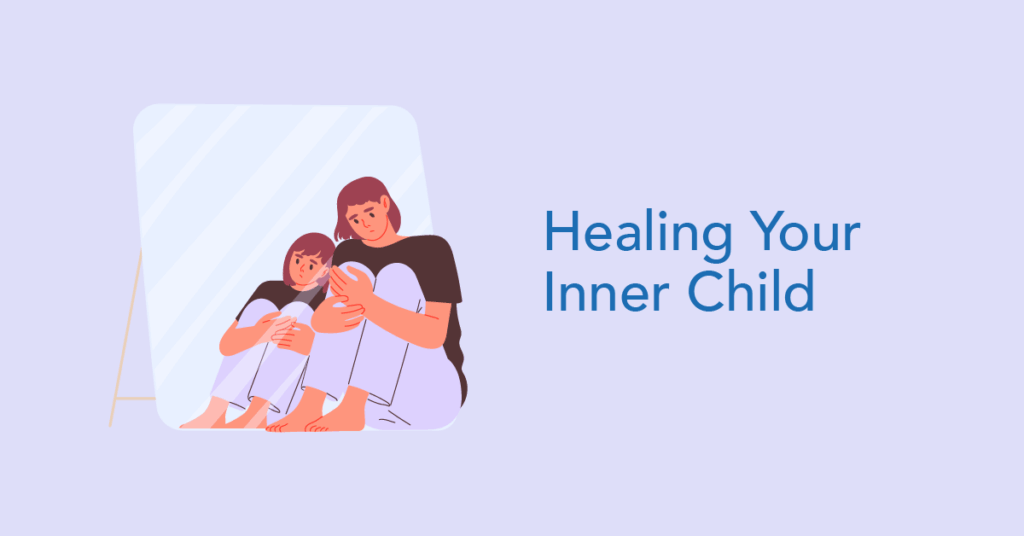Healing your inner child means reconnecting with the parts of yourself shaped by early experiences, offering those parts compassion, safety and support in the present.
You may have heard the phrase “inner child” in therapy circles or self-help spaces. It might sound abstract at first, but the concept is grounded in real psychology. For many, it’s a powerful tool for emotional healing.
Your inner child is the part of you that still holds onto early feelings, unmet needs and coping mechanisms formed during childhood. It influences how you relate to others, handle emotions and respond to stress. When this part of you goes unacknowledged or is wounded, it can quietly impact your adult life in painful ways.
Healing your inner child isn’t about blaming the past. It’s about understanding yourself more fully, meeting your unmet needs and giving yourself the care you didn’t always receive.
What Is the “Inner Child”?
The inner child is a psychological concept referring to your original self, the child you once were and still carry inside. It holds your early emotional experiences, including both joyful memories and painful ones. This part of you can show up in adult life in both helpful and unhelpful ways.
Your inner child might:
- Crave affection, safety or approval
- React strongly to rejection or abandonment
- Struggle to trust others
- Become playful, curious or imaginative
- Shut down emotionally when overwhelmed
When childhood was marked by trauma, neglect or unmet emotional needs, the inner child often carries wounds that resurface later in life, sometimes as anxiety, low self-esteem or difficulty forming healthy relationships.
Signs Your Inner Child Might Be Wounded
You don’t need to have experienced severe trauma to carry a wounded inner child. Even well-meaning parenting or everyday life events can leave emotional gaps.
Some signs of inner child wounds include:
- Difficulty setting boundaries
- Fear of being “too much” or “not enough”
- Chronic people-pleasing
- Deep shame or guilt
- Explosive or withdrawn reactions to stress
- Feeling unworthy of love or success
These patterns can affect relationships, self-worth and emotional stability and often don’t improve without intentional healing.
What Does It Mean to Heal the Inner Child?
Healing your inner child involves recognizing that part of you, listening to what it needed and offering support in a way your younger self never received. This may include:
- Validating emotions that were dismissed or ignored
- Releasing shame that was never yours to carry
- Relearning trust, safety or playfulness
- Offering yourself compassion during moments of struggle
In therapy, this might look like guided imagery, letter writing, inner dialogue exercises or simply creating safe emotional space for old wounds to surface and be met with understanding.
How Inner Child Work Is Used in Therapy
Therapists often incorporate inner child healing into modalities like:
- Internal family systems (IFS). A framework where different “parts” of you, including the inner child, are heard, validated and integrated
- Trauma-informed therapy. Helps clients explore early experiences that shaped current emotional patterns
- Cognitive behavioral therapy (CBT). Can challenge beliefs rooted in childhood messages (e.g., “I have to be perfect to be loved”)
- Art or play therapy. Encourages creative, nonverbal processing often connected to early experiences
Even simply acknowledging the inner child in moments of pain, such as saying “It makes sense that I feel this way,” can be healing.
Practical Ways to Connect With and Heal Your Inner Child
You don’t need to be in therapy to begin this work, though professional support can deepen it. Here are ways to start:
1. Reflect on Childhood Needs
Ask yourself:
- What did I need as a child that I didn’t get consistently?
- Was I allowed to express emotions safely?
- Did I feel loved without conditions?
- Were my boundaries respected?
Understanding these unmet needs can show you where emotional patterns originated.
2. Write a Letter to Your Younger Self
Use this exercise to speak directly to your inner child. Offer the words you wish someone had said to you then. You might write:
- “I see you.”
- “You didn’t deserve what happened.”
- “You’re not a burden.”
- “You’re loved and safe now.”
This can bring up emotions, which is a normal and healing part of the process.
3. Reparent Yourself
“Reparenting” means giving yourself now what you didn’t get then. That might include:
- Setting healthy boundaries
- Creating routines that feel safe and consistent
- Prioritizing self-care
- Using kind, affirming self-talk
- Allowing yourself rest, play or joy
Reparenting isn’t about perfection; it’s about consistent self-compassion.
4. Listen to Emotional Triggers
When you have a strong emotional reaction to something in the present, it might be your inner child reacting to something familiar. Ask:
- What age does this feeling remind me of?
- Have I felt this kind of fear or shame before?
- What would I want to say to that younger version of myself?
Responding to those emotions with understanding can shift how you handle them over time.
Frequently Asked Questions
- Do I Have to Remember My Childhood Clearly to Do Inner Child Work?
Not at all. Some people have limited memories due to trauma or time. You can still explore your emotional patterns, triggers and needs today — your present experience is valid and valuable. - Is Inner Child Work the Same as Therapy?
It can be part of therapy, but you can also do this work through journaling, self-help books or support groups. However, if deep pain or trauma surfaces, it’s best to have a therapist guide you. - What If I Feel Silly or Resistant to the Idea?
That’s completely normal. Many adults were taught to ignore or suppress emotions. It takes time to build comfort with this work, and there’s no wrong way to start. - Can Healing My Inner Child Help With Anxiety or Depression?
Many emotional struggles in adulthood are tied to unmet needs or core beliefs formed in childhood. By tending to those old wounds, you may find relief, self-acceptance and healthier coping strategies.
You Deserve to Feel Whole
Healing your inner child isn’t about getting stuck in the past. It’s about honoring the parts of you that still carry pain, confusion or unmet needs and learning how to give those parts the love and safety they never received.
If you’re starting to recognize trauma patterns in yourself, know that healing is possible and you don’t have to do it alone.
The Mental Health Hotline offers free, confidential support 24-7. Whether you’re curious about therapy, feeling overwhelmed by old wounds or simply need someone to talk to, help is here.


